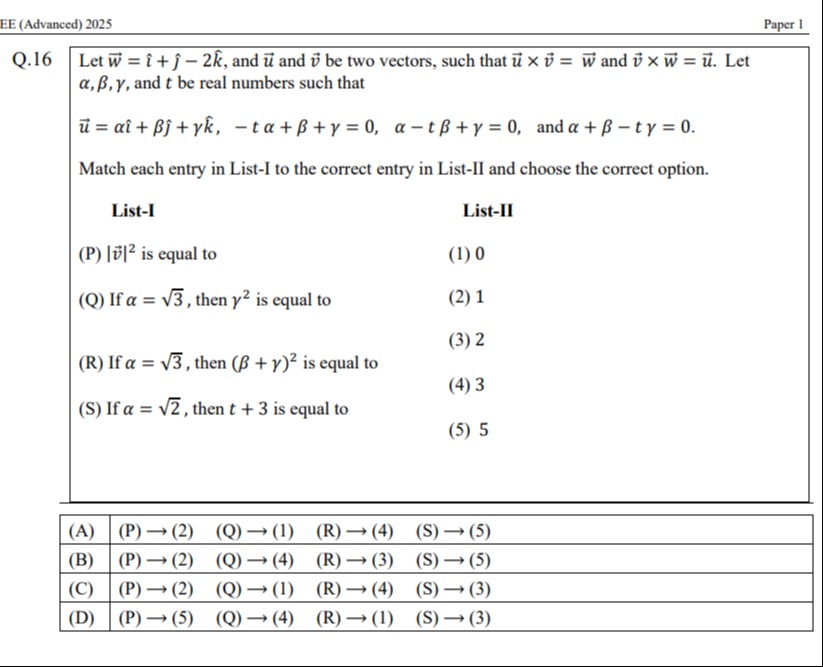Question
Question: Let $\overrightarrow{w} = \hat{\imath} + \hat{\jmath} - 2\hat{k}$, and $\overrightarrow{u}$ and $\ov...
Let w=^+^−2k^, and u and v be two vectors, such that u×v=w and v×w=u. Let α,β,γ, and t be real numbers such that
u=α^+β^+γk^, −tα+β+γ=0, α−tβ+γ=0, and α+β−tγ=0.
Match each entry in List-I to the correct entry in List-II and choose the correct option.
List-I List-II
(P) ∣v∣2 is equal to (1) 0
(Q) If α=3, then γ2 is equal to (2) 1
(3) 2
(R) If α=3, then (β+γ)2 is equal to (4) 3
(S) If α=2, then t+3 is equal to (5) 5

(P) → (2) (Q) → (1) (R) → (4) (S) → (5)
(P) → (2) (Q) → (4) (R) → (3) (S) → (5)
(P) → (2) (Q) → (1) (R) → (4) (S) → (3)
(P) → (5) (Q) → (4) (R) → (1) (S) → (3)
A
Solution
First, let's analyze the given vector equations: u×v=w and v×w=u.
From the properties of the cross product, w is orthogonal to both u and v. Also, u is orthogonal to both v and w. This implies that u,v,w are mutually orthogonal vectors.
The magnitude of w is ∣w∣=∣^+^−2k^∣=12+12+(−2)2=1+1+4=6.
Taking magnitudes of the given vector equations: ∣u×v∣=∣w∣ and ∣v×w∣=∣u∣. Since u and v are orthogonal, ∣u×v∣=∣u∣∣v∣sin(90∘)=∣u∣∣v∣. Since v and w are orthogonal, ∣v×w∣=∣v∣∣w∣sin(90∘)=∣v∣∣w∣. So, we have: ∣u∣∣v∣=∣w∣=6 ∣v∣∣w∣=∣u∣ Substitute ∣w∣=6 into the second equation: 6∣v∣=∣u∣. Substitute this into the first equation: (6∣v∣)∣v∣=6⟹6∣v∣2=6. This gives ∣v∣2=1.
(P) ∣v∣2 is equal to 1. So (P) → (2).
We are given u=α^+β^+γk^ and a system of linear equations for α,β,γ:
- −tα+β+γ=0
- α−tβ+γ=0
- α+β−tγ=0 This is a homogeneous system of linear equations. Since u=0 (because ∣u∣=6=0), the system must have a non-trivial solution. This requires the determinant of the coefficient matrix to be zero: −t111−t111−t=0 −t(t2−1)−1(−t−1)+1(1+t)=0 −t3+t+t+1+1+t=0 −t3+3t+2=0⟹t3−3t−2=0. Factoring the cubic: (t+1)2(t−2)=0. The possible values for t are t=−1 or t=2.
Case 1: t=−1. The system becomes: α+β+γ=0 α+β+γ=0 α+β+γ=0 The condition is α+β+γ=0. We also know that u is orthogonal to w=^+^−2k^. u⋅w=(α^+β^+γk^)⋅(^+^−2k^)=α+β−2γ=0. We have the system: I) α+β+γ=0 II) α+β−2γ=0 Subtracting II from I gives 3γ=0⟹γ=0. Substituting γ=0 into I gives α+β=0⟹β=−α. So, for t=−1, β=−α and γ=0. The condition ∣u∣2=6 implies α2+β2+γ2=6. α2+(−α)2+02=6⟹2α2=6⟹α2=3.
Case 2: t=2. The system becomes: −2α+β+γ=0 α−2β+γ=0 α+β−2γ=0 From the first two equations: (−2α+β+γ)−(α−2β+γ)=0⟹−3α+3β=0⟹α=β. From the second and third equations: (α−2β+γ)−(α+β−2γ)=0⟹−3β+3γ=0⟹β=γ. So, for t=2, α=β=γ. The condition ∣u∣2=6 implies α2+β2+γ2=6. α2+α2+α2=6⟹3α2=6⟹α2=2. This is consistent with u⋅w=α+β−2γ=α+α−2α=0.
Now we evaluate the expressions in List-I based on these findings.
(P) ∣v∣2: We found ∣v∣2=1. Matches (2).
(Q) If α=3, then γ2 is equal to. If α=3, then α2=3. This occurs when t=−1. In this case, γ=0. So γ2=02=0. Matches (1).
(R) If α=3, then (β+γ)2 is equal to. If α=3, then this is the case t=−1, where β=−α and γ=0. β=−3 and γ=0. (β+γ)2=(−3+0)2=(−3)2=3. Matches (4).
(S) If α=2, then t+3 is equal to. If α=2, then α2=2. This occurs when t=2. So t=2. t+3=2+3=5. Matches (5).
Summary of matches: (P) → (2) (Q) → (1) (R) → (4) (S) → (5)
Let's check the options provided. (A) (P) → (2) (Q) → (1) (R) → (4) (S) → (5) - This matches our results. (B) (P) → (2) (Q) → (4) (R) → (3) (S) → (5) - Incorrect. (C) (P) → (2) (Q) → (1) (R) → (4) (S) → (3) - Incorrect. (D) (P) → (5) (Q) → (4) (R) → (1) (S) → (3) - Incorrect.
The correct option is (A).
